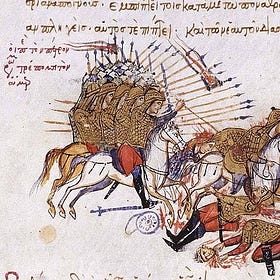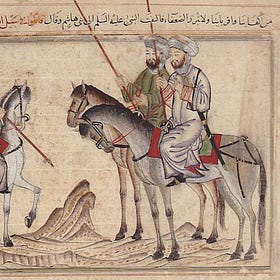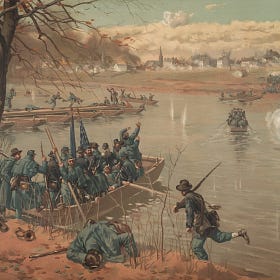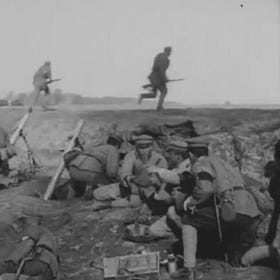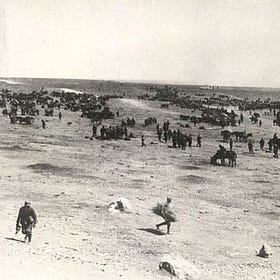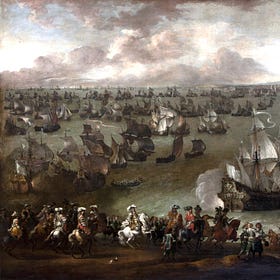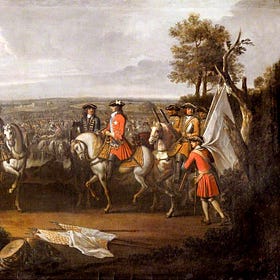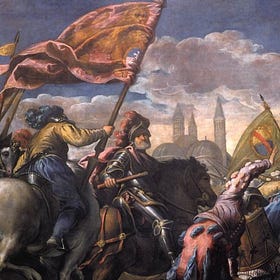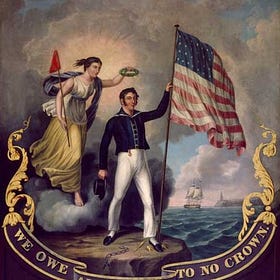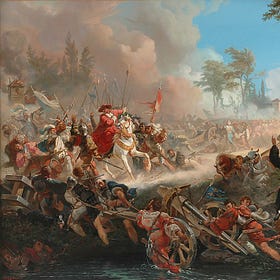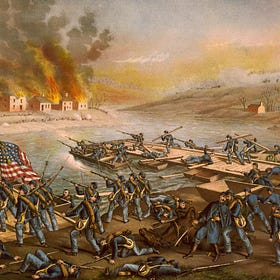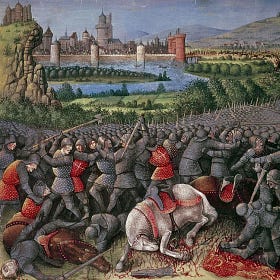Paid Subscribers
Below are all subscriber-exclusive Dispatches, with free previews for non-subscribers.
The Birth of Byzantine Operational Art: The Arab-Byzantine Frontier, Part 2
The last piece on Arab-Byzantine warfare looked at strategy along the Anatolian frontier in the first century of the Islamic conquests. We saw how the Arabs followed a two-track policy: to conduct frequent but limited raids, similar to the logic that defined Native American warfare
Strategy in an Endless War: The Arab-Byzantine Frontier, Part 1
One of the most compelling points in Wayne Lee’s The Cutting-Off Way was the strategic logic of Native American warfare. For societies with low population densities which depended on hunting for subsistence, it was simply not possible to conquer and occupy territory. Tribal territory, such as it was, consisted of vast hunting grounds that made possession a much vaguer concept, and men could not be spared for fortress garrisons which would render it more concrete.
Contested Crossings: Fighting Across Rivers in the Gunpowder Age
In 1297, Edward I of England sent an army into Scotland under the Earl of Surrey to put down William Wallace’s rebellion. After arriving at Stirling Castle, Surrey found the Scots drawn up on the opposite side of the River Forth. Wallace had positioned his men some ways back from the river itself, so Surrey decided to advance, anticipating that he would have time to form up his army before becoming engaged.
A Military-Industrial Complex With a State: Sweden in the 17th Century
Mirabeau’s witticism about Prussia in the 18th century could have just as easily been said of Sweden in the 17th. From the first expansionary wars in the 1560s through the death of Charles XII in 1718, her kings were at war for 108 out of 158 years. Despite a small home population, the Swedish army grew in excess of 150,000, while the navy briefly became the fourth-largest in Europe. At the height of its glory, the Swedish Empire seemed more a military with a state than a state with a military.
Successors to the Western Front, Pt. 2: The Second Zhili-Fengtian War
The period from 1920 to 1928 was the height of the Warlord Era, in which China was wracked by civil conflicts between rival military factions. Some vied for control of the central government, while others sought to retain their autonomy in more far-flung provinces. It was only the Northern Expedition, which swept across the entire country and brought China under the Kuomintang’s unitary control, that the period finally ended.
Successors to the Western Front, Pt. 1: Operational Maneuver in the Greco-Turkish War
World War I came at a very particular technological moment. The new weapons that made combat so lethal also made mobile warfare far more difficult: not only did they lend the defender an edge, but their voracious appetite for ammunition overwhelmed the primitive logistical apparatuses of the time. Trains could resupply static positions, but new track could not be laid in time for a rapid advance, leaving armies dependent on animal-drawn carts and small motor pools. Just a generation or so earlier, large armies were still light enough to conduct sweeping envelopments; a generation later, they were sufficiently motorized to keep pushing after a breakthrough. But in 1914, it was both tactically difficult to penetrate enemy lines and operationally difficult to exploit it.
Red Sea Pirates! Commerce Raiding During the Crusades
Since attention is back on Houthi attacks on shipping off Yemen, I thought that it would be worth looking at an earlier episode of attacks on Red Sea commerce that took authorities by surprise. This was one of the more colorful incidents of the Crusades, undertaken by the semi-rogue baron Reynald of Châtillon against Saladin, the sultan of Egypt and Syria. Over the winter of 1182-83, he terrorized merchants and pilgrims on and around the Red Sea in an audacious campaign of brigandage, forcing a panicked response from authorities in Cairo.
Sea Power in Continental Wars: Naval Strategy Under Louis XIV & XV
The great 15th-century voyages of discovery which inaugurated the Age of Sail also opened new fields of competition to European powers. Spanish gold and Portuguese spice provoked the envy of other powers, and soon Dutch, English, and French corsairs were raiding their overseas convoys. By the end of the 16
A War on Many Stages: Theater Strategies and the War of the Spanish Succession
On 1 November 1700, Charles II of Spain died without issue. He had long been suffering from an extended illness, and his last years were occupied with the question of succession. The two leading candidates were from the great rival houses of Europe: his Habsburg cousin Archduke Charles (son of Emperor Leopold of Austria) and his Bourbon nephew Philip of Anjou (grandson of Louis XIV of France). Philip ultimately won out, ending the longstanding antagonism between Spain and France. This drastically altered the balance of power in Europe, setting in motion a series of events that led to the longest and most destructive war in the reign of Louis XIV.
Red Commissars of the Serene Republic: The Venetian Way of War
The gap between operations and strategy is the hardest to span. Although military questions are ultimately subordinate to political prerogatives, generals and politicians must in some sense meet as counterparts of two equal domains. While generals have risen through the ranks and understand the problems facing their own subordinates, the apprenticeship for political leadership only rarely affords them any deep understanding of military affairs. Generals may similarly misunderstand why political prerogatives override operational considerations and fail to adapt their operations accordingly.
Grand Strategy on the Political Stage: America in the War of 1812
Between 1812 and 1814, a coalition slowly mobilized to defeat Napoleon. It began with Russia fighting alone against the French invasion, supported by British subsidies and operations in Spain. Sweden and Prussia joined soon after, followed by Austria and a slew of smaller states. In just under two years, the Sixth Coalition drove the
Crowning the King of Battle: Field Artillery in the Italian Wars
This piece focuses on several key battles during the Italian Wars. For more on the broader tactical developments and general history of the period, I recommend Frederick Taylor’s The Art of War in Italy: 1494-1529, which paid Dispatch subscribers receive free.
The Rappahannock Line: Mobile Warfare Along a Frozen Front
For the first three years of the American Civil War, the Rappahannock River was the effective boundary between North and South. Even as the war sprawled halfway across the North American continent, the attention of most observers remained focused on northern Virginia. This was the crucial theater, the contested ground between Washington, DC and Richmond, where the war was most likely to be decided. As such, operational considerations in this sector took on an outsized importance, shaping both sides’ strategies. And of these, the greatest was the Rappahannock: a modest river of some 300 kilometers in length.
Venice and the Problem of Grand Strategy
The last two decades of the 15th century saw the Venetian empire at its peak. Domination of the Mediterranean spice trade turned Venice into the most important commercial hub in Europe, drawing a steady stream of gold and silver into its coffers. This wealth was built upon sea power: the Venetian navy was the strongest of any European power, outfitted with the best ships and sailors in the world. At home, Venice enjoyed domestic tranquility, suggested by the name
The Fighting March: Operational Mobility During the Crusades
Operational mobility is a universal challenge in war. Enemy action, supply problems, transportation breakdowns all compound one another to make simple things difficult. By the same token, these impediments create an opportunity: whichever side can overcome them gains an enormous advantage over its adversary.
The Northern Front: Trench Warfare in the 18th Century
Artillery flies over the heads of soldiers huddling in the trenches as they steel themselves for what is to come. These men have fought countless similar actions over the past few years, each time hoping to pierce the enemy’s lines and bring the war to an end. But each time their hopes are dashed: they make only incremental progress at great cost in blood, and the enemy always manages to fall back on even stronger positions. Lulled by the sounds of their guns pounding the enemy’s positions, the soldiers’ reveries are interrupted by the sergeant’s whistle. With a shout, they leap as one over the top and charge across open ground. Many are cut down in the hail of fire that greets them, but most make it to the enemy trenches. Their firearms become melee weapons as they stab, shove, and club the defenders, cries in English, French, and German rising above the din.

